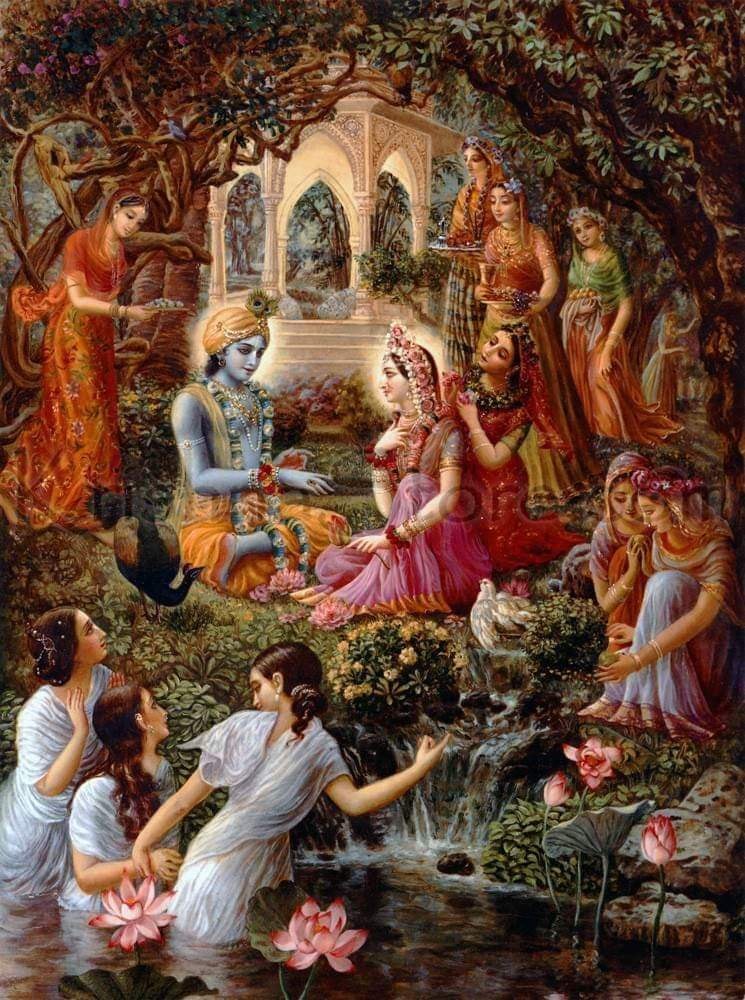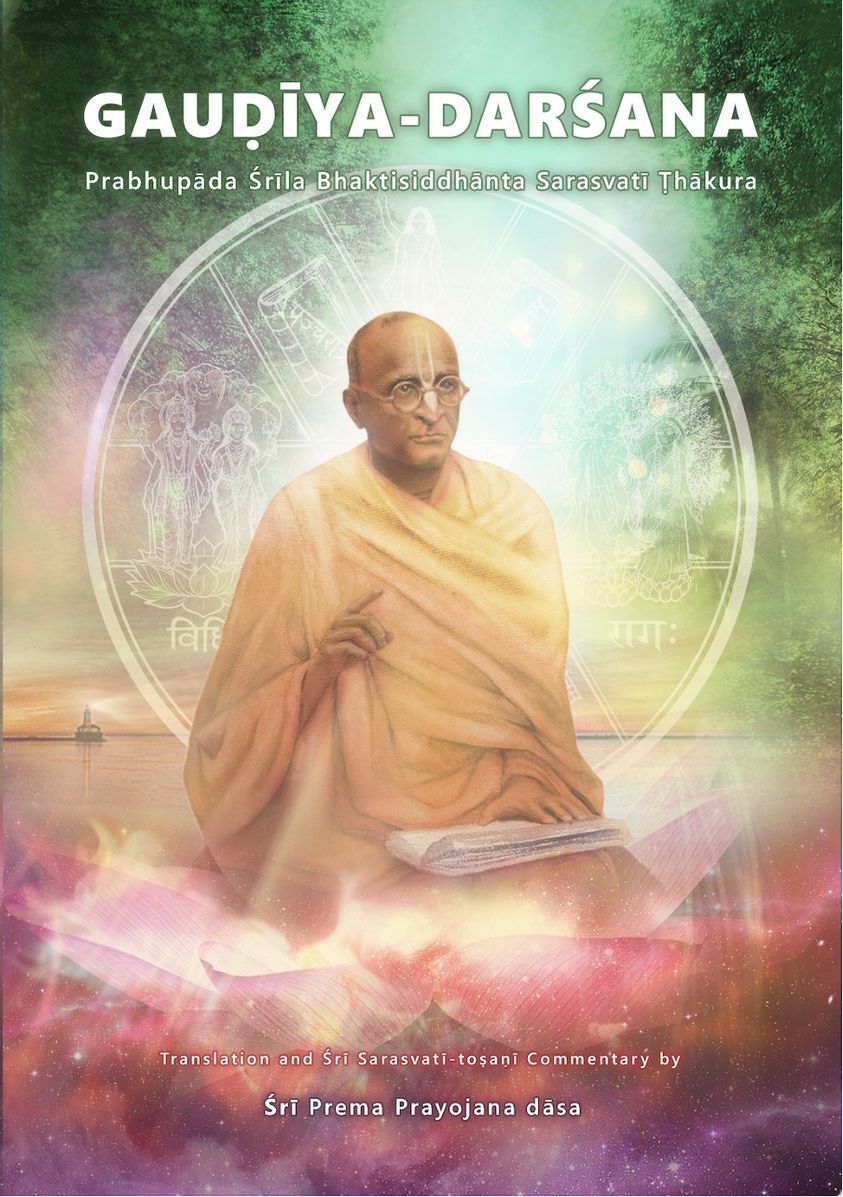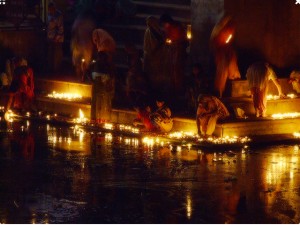
What is the Hare Krishna Movement? (summary)
Where do the teachings come from?
Are the Hare Krishna Devotees Hindus?
What are the teachings?
Do you believe in reincarnation?
What is the Hare Krishna chant?
What are the Practices?
Why are you vegetarian?
Is it necessary, to wear orange and have a shaved head?
What do you do all day?
Do you do anything else?
Why do you sing and dance in the streets?
I am interested. How do i find out more?
What is the Hare Krishna Movement?
Only five hundred years ago, Lord Krishna descended as Sri Caitanya Mahaprabhu to teach the most sublime and effective means of meditation for the present day: the chanting of the names of God, especially as found in the Hare Krishna mantra. Today, all members of Lord Caitanya's movement continue His movement by distributing the teachings of Lord Krishna and the Hare Krishna mantra all over the world
The Grimsby & Cleethorpes UK Hare Krishna Society IPBYS is a small independent branch of Lord Caitanya's movement of Devotees, which can be found all over the planet and carries on in the modern world a great ancient tradition rooted in the Bhagavad-Gita, the teachings Lord Krishna spoke five thousand years ago. The Bhagavad-Gita and the other Vedic scriptures declare Krishna to be the original person, God Himself, who appears periodically in this world to liberate all living beings.
Where do the teachings come from?
Although the Hare Krishna movement has only been established in the West since 1966, its roots extend tens of thousands of years into the planets past. The lifestyle and philosophical beliefs are based on ancient scriptures known as the Vedas. Originally preserved in the spoken word, the Vedas were written down in the Sanskrit language 5000 years ago.

Sanskrit, the ancient language of the Vedas
Their compiler, Srila Vyasadeva, divided the work into various departments of material and spiritual knowledge, entrusting his disciples with particular sections. In this way, the scriptures developed into four principal Vedas, including the Vedanta Sutra, 108 Upanishads, and 18 Puranas, collectively known as the "fifth Veda." The final Purana, the Bhagavat Purana or Srimad Bhagavatam, contains the essence of the Vedic wisdom in 18,000 verses. A further work was the Mahabharata, which includes the well-known Bhagavad gita. The process described in the Vedas is one of gradual elevation to the platform of God-realisation. Vedic wisdom was then carefully preserved and passed down for centuries through the tutorial vehicle of guru-parampara, a disciplic succession of self-realised teachers.
In the early 16th century, a remarkable spiritual renaissance took place within India. This was led by Sri Chaitanya Mahaprabhu who appeared in 1486. He was Lord Krishna Himself in the form of His own devotee. He challenged the religious leaders of his day whom he felt were stifling the teachings of Vedic knowledge. Caste-conscious priests alone had access to the Vedas and considered spiritual life the prerogative of an educated minority. Taking religion out of the temples and amongst the people, regardless of their caste, Sri Chaitanya Mahaprabhu propagated devotion to Lord Krishna and pioneered a massive movement which swept the subcontinent, gaining a following of millions.
The ancient wisdom of the Puranas and Upanishads, through the practical teachings of Sri Chaitanya are now finding expression outside India in the Hare Krishna movement and the books of Srila Bhaktivedanta Swami Prabhupada and Srila Bhaktivdanta Narayana Maharaja.
Are the Hare Krishna Devotees Hindus?
The Vedas are sacred to the 600 million members of Hinduism, the world's third largest religion. And Bhagavad gita, one of the essential texts of the Hare Krishna Movement, is often referred to as "The Bible of Hinduism." Yet the word "Hinduism," itself simply means the "ism" of India, the word "Hindu" first being used by the Persians to denote "those on the other side of the Indus river." As such, the term "Hinduism" describes not a single, monolithic religion, but a vast spectrum of diverse spiritual paths, tracing their origins to particular branches of the Vedas. The oldest and most cohesive of Vedic traditions is that of the Monotheistic sanatana dhama, "the eternal original teaching," academically known as Vaishnavism. As such Krishnas devotees, are also known as Vaishnavas
What are your teachings?
It is often assumed that the final goal of Indian spirituality is nirvana – the extinguishing of individual existence and the simultaneous absorption into an amorphous Absolute. This is not so, In the Bhagavad-Gita Lord Krishna reveals that the eternal self, the soul, can not be extinguished or annihilated in any way and that the goal of life is the awakening of the soul's eternal consciousness of Krishna, the personal form of the Absolute Truth.
In brief, Lord Krishna teaches, that
-
We are not our bodies, but eternal spirit souls (atma), parts and parcels of Him (Krishna). Although our nature is completely spiritual (brahman), we have temporarily forgotten our true identity.
-
Having lost touch with our original, pure and blissful consciousness, we are trying to achieve permanent happiness within a temporary world. Our attempts produce karmic reactions which cause us to remain within this world for repeated lifetimes (samsara).
-
By sincerely learning and following a genuine spiritual science (dharma) under the guidance of a self-realised teacher, we can be free from anxiety and come to a state of pure, blissful enlightenment in this lifetime.
-
Krishna is eternal, all-knowing, omnipresent, all-powerful and all-attractive. He is the seed-giving father of all living beings and He is the sustaining energy of the entire cosmic creation.
-
Our dormant relationship with Krishna can he reawakened by the practice of bhakti-yoga, the science of spiritualizing our activities (excluding some) by dedicating them to the Supreme. This ancient bhakti yoga system gradually frees us from the entanglement of karma, and thereby the cycle of birth and death.
Do you believe in reincarnation?
The Bhagavad-Gita states that life does not begin at birth nor end with death. It is eternal. The soul is constantly transmigrating from one body to another according to its desires and quality of activities (karma). The Vedas further explain that the soul in the material world moves through a cycle of 8,400,000 forms of life. The human form, however, is the only birth which affords one the chance for self-realisation. Lower-than-human species are not endowed with sufficient intelligence to understand the self as different from the body.
You meditate?
Members of the Hare Krishna movement practise mantra meditation. In Sanskrit, manah means "mind" and tra means "freeing". A mantra is a combination of words that is meant to relieve the mind of anxieties arising from wordly entanglement. Vedic literature compares the mind to a mirror, and our present state of spiritual forgetfulness to a mirror which has accumulated dust. Mantra meditation clears the dust from the mirror of the mind so that we can see our original self. When our spiritual nature is inwardly perceived, then the anxieties caused by illusion cease, and we experience spiritual happiness.
What does chanting Hare Krishna mean?
All devotees of Lord Krishna chant the Hare Krishna mantra:
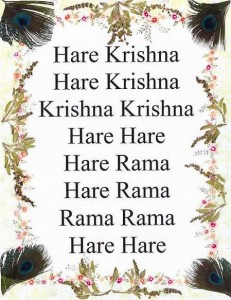
The Hare Krishna Mantra. Man means mind and tra to free
Because the Vedas refer to it as the maha – mantra or "Great Mantra". This sixteen-word mantra is especially recommended as the easiest method for self-realization in the present age. Krishna is a Sanskrit name of God meaning "all attractive", and Rama is another name meaning "reservoir of pleasure". The divine energy of God is addressed as Hare. Vedic knowledge teaches that since we are all constitutionally servants of God, the chanting of His names is not an artificial imposition on the mind but is as natural as a child calling for its mother. There are two ways to chant the maha mantra: group chanting (kirtan) and softly saying the mantra to oneself (japa). The latter is done by using a string of 108 wooden prayer beads to enhance concentration. In both methods there are no hard and fast rules, and anyone can chant with good results.
What else do you practice?
There are four simple practices in Krishna consciousness.
Reading (Shravanarn)
Reading provides the intellectual satisfaction that is essential to developing faith in any spiritual practise. Without a comprehensive body of philosophical knowledge, any religious tradition can easily become a system of unfounded beliefs and rituals. Vedic literature offers logical answers to profound questions, and when carefully studied, books like Bhagavad-Gita will allow the inquisitive reader an opportunity to explore many new ideas and concepts.
The books of His Divine Grace A.C. Bhaktivedanta Swami Prabhupada are translations and commentaries upon India's timeless spiritual classics, written over a period of twenty years. His writings comprise a complete course of study in bhakti-yoga, and are the basis of the spiritual lives of Hare Krishna members around the world.
Studies usually begin with Bhagavad-Gita, Isopanishad, Srimad Bhagavatam and The Teachings of Lord Chaitanya. Devotees study at least a few minutes daily, reserving a quiet period when they can read without disturbance.
Chanting (Kirtanam)
Recitation of the Hare Krishna mantra is the essential practise of Krishna consciousness. Devotees may spend from 10 minutes to 2 hours per day chanting japa. Once around the circle of 108 beads is called a "round" and devotees will chant anywhere between one and sixteen "rounds" per day as their time and inclination permits. Chanting is done either sitting or walking, usually in the morning. At first the language of the mantra may feel strange but as the profound nature of the sound vibration is experienced any feelings of awkwardness disappear.
Anyone who chants with sincerity, pronouncing the words distinctly and listening attentively, will become peaceful and experience a sense of happiness. One who continues the process becomes advanced in the techniques of mantra meditation and enjoys the awakening of the soul's natural, original qualities of eternity, knowledge, and bliss.
Friendship (Sat-sangam)
Our friendships have tremendous influence upon the way we think and act. We may enthusiastically take to a more spiritual way of life, but if our friendships with others are not similarly transformed, our personal development may become checked. Associating with others who are spiritually inclined is therefore one of the most important and rewarding aspects of the Hare Krishna way of life.
New members of HARE KRISHNA SOCIETY – IPBYS usually start off by linking up with others in the same town or county. Regular meetings take place in many parts of the world, even where there is no temple, in hired rooms or devotee's homes. see Grimsby Meetings People are often surprised when they come to these meetings to find themselves developing very gratifying friendships.
Apart from local meetings, members cultivate friendships with others through correspondence, or by hosting visits, from traveling teachers. large events like the yearly London Chariot Festival (Rathayatra) are social and spiritual gatherings where thousands of members meet up both to celebrate and enjoy each others company. The network of Krishna centres, meetings, shops and temples, is steadily growing. As it does, many more people are discovering the personal benefits of being part of a spiritual community. Worldwide Centres
Remembering (Smaranam)
The aim of Krishna consciousness is to cultivate a constant flow of awakened states of consciousness wherein we remember our spiritual identity and our relationship with Krishna. Vaishnavas therefore begin the day with a combination of practices, which help to focus the mind spiritually. Rising early, bathing, japa meditation and study, all purify the mind from its sleepiness and create a mental state suitable for an entire day of spiritual progress.
The Vedic literature teaches that our daily actions should lead us to develop valuable personal qualities such as peacefulness, tolerance, honesty and compassion. To this end, members also adopt regulative principles like vegetarianism as part of their personal lifestyle. In this way, even our most basic daily function of eating, can be an integral part of our spiritual path.
The Vedic scriptures establish non-violence (ahimsa), as the ethical foundation of vegetarianism. According to the Vedas, God is the Supreme Father of all creatures, not just humans. Therefore, the slaughter of innocent animals is considered equivalent to killing one's brother or sister.
Hare Krishna devotees follow a wholesome diet, which excludes meat, Fish and eggs. Although it may be argued that vegetarians are guilty of killing vegetables, vegetarian foods such as fruits, nuts, milk, and grains do not require killing. But even when a plant's life is taken, the pain it experiences is dramatically less than that of a highly sensitive animal such as a cow or lamb.
According to the law of karma, nature's law of action and reaction, human beings must suffer for any kind of killing that is against God's laws. For this reason, as well as to show recognition and appreciation for the Supreme Proprietor and supplier of all foodstuffs, devotees prepare vegetarian meals as devotional offerings to Krishna. Such spiritualised food is then called prasadam ("the mercy of Krishna"), which can be fully enjoyed.
Why do the Hare Krishna devotees look like Buddhist monks?
It is not necessary to look like this, there are millions of devotees worldwide, who don't live in the temples and wear regular cloth and hair syles, because of their circumstances.
Shaven heads and orange robes actually pre-date Buddhism by many centuries. In Vedic culture a person dressed according to his or her social and spiritual position. Simple robes, although external, have traditionally been worn to help cultivate humility and freedom from vanity.
In keeping with this reasoning, the Hare Krishna Movement has retained certain elements of Vedic tradition wherever practical. Following this principle, women in Hare Krishna communities wear the traditional saree, while men wear robes known as dhotis.
Young men who have gone forward to observe a celibate student life and train as monks wear saffron colored robes; married men wear white. Most choose to shave their heads leaving a single lock of hair in the back called a sikha. This is done as a sign of renunciation and surrender to Krishna, as well as for cleanliness and simplicity. The U-shaped marking of clay on the forehead is known as tilak, and is made with a yellow clay from the banks of sacred rivers in India. Together with these traditional ascetic practices, fully committed devotees of Krishna, whether residing in a temple community or not, also abstain from all types of intoxication, and do not gamble or have sexual relationships outside of marriage.
What do you do all day?
The activities of the members of HARE KRISHNA SOCIETY – IPBYS are as varied as their strikingly diverse lifestyles. For instance, although most members are naturally vegetarian, all other practises are a matter of their personal choice and commitment. Thus one member of HARE KRISHNA SOCIETY – IPBYS lives in a religious community, rises at 4 o'clock in the morning, and leads a strict monastic life, while another cares for a young family or works in a busy office. The circumstances may vary greatly but the basic aim is the same.
Why do you sing and dance in the streets?
Most scriptures of the world, and particularly the Vedas, extol the chanting of God's names as a powerful means of spiritual realization. Someone who enjoys their spiritual life naturally feels inclined to share it with others. This enthusiasm caused the founder of HARE KRISHNA SOCIETY – IPBYS to not only teach Krishna consciousness, but to organize his early students as a formal society for the purpose of teaching others. Devotees of Krishna, therefore will often be found in public places performing sankirtana, by chanting with musical instruments, as done by Sri Chaitanya Mahaprabhu just over 500 years ago.
Do you do anything else?
Lots and lots and lots, for example here are just a few of our activities
- Residential training courses in the theology, philosophy, history and practices of Vaishnavis
- "Hare Krishna Festivals, to introduce larger audiences to our Vaishnava culture through music, art, dance, theater and film eg.
- Free food distribution programs
- A world wide book publishing department and warehouses
-
Mail-order service supplying literature, videos, audio-tapes, posters, incense and health product
vegetarian cooking - Speaking engagements and demonstrations at schools and universities
-
local meetings, centres, shops and the associated activities
Free book distribution of transcendental literature and book tables all over the world
Community outreach to teach Krishna Meditation to all. -
Yes, we would like to invite you, to come and meet us 🙂
Please get in touch with your local Centre or devotees.
Worldwide Centres
Grimsby Meetings
or email Devarsi
devarsiATharekrishnasociety.com
Please replace AT with @
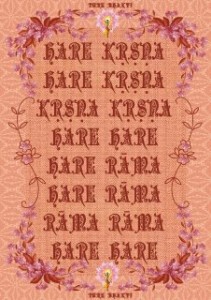

 Posted in
Posted in 







